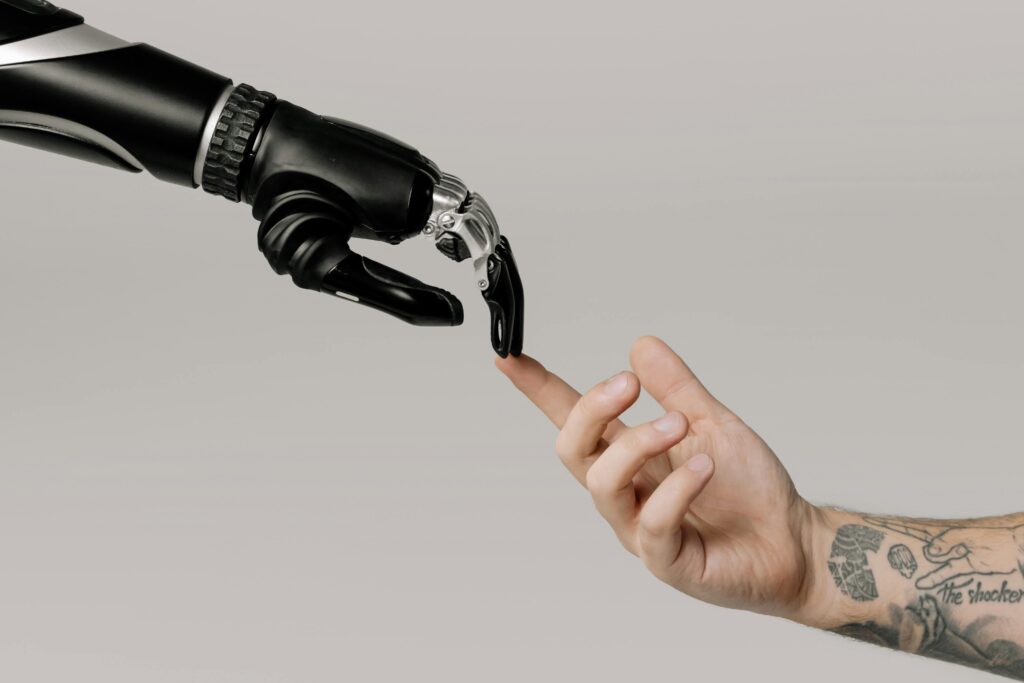The rise of AI has a lot of us wondering – are we creating our successors? Will machines take over our jobs, creative endeavors, and philosophical ponderings? It’s a mind-boggling question, but we need to address it head-on.
The reality is that AI is becoming increasingly complex and it is no longer a matter of ‘what’ but it is a matter of ‘what our role is’ in this new world. Let us introduce Human in the Loop machine learning – a revolutionary approach that shifts the perspective.
The misconception people tend to have is that AI equals Automation – the plain and simple replacement of human tasks. But what if this viewpoint is changed? What if we approached the development of AI as a symbiotic process where humans remain the main stakeholders guiding the process?
HITL is exactly what it is; humans are in the loop. Human in the loop machine learning is a symbiosis where man and AI systems come together to achieve accurate and verifiable results.
The idea behind HITL is that Computers can process numerical data, analysis, recognition, and predictions. However, we humans are the ones who assign meaning as humans, give the context, and then add the creative spark that makes AI creative by utilizing the Human in the Loop approach. Let us explore how the Human in the Loop AI approach is revolutionizing AI incorporation in different industries.
“I’m increasingly inclined to think that there should be some regulatory oversight, maybe at the national and international level, just to make sure that we don’t do something very foolish. I mean with artificial intelligence we’re summoning the demon.”
—Elon Musk
Beyond Automation: Human in the Loop Machine Learning
In case you are wondering what is HITL? Human in the loop machine learning uses Grounding AI as a technique to add accountability to AI systems, presenting their decision-making logic. It maintains human control over decisions while safeguarding ethics and values, guaranteeing value-based results. Moreover, it helps AI learn much faster, as its users continue to share feedback and suggestions with it.
The progress of artificial intelligence has been quite impressive in recent years and its exponential growth indicates the ability of algorithms to transform industries. However, a potential problem with full automation is that creativity and intellect are not able to be fully automated.
The creativity that is involved in creating something new, the emotions that one identifies with his work, and the aptitude that humans possess in handling situations are incomparable to that of machines.
It thus becomes apparent that HITL or Human-in-the-Loop machine learning forms a solution that embraces this integration. It builds upon the capabilities of both, in which AI receives directions and instruction from humans and where humans on the other hand make use of the computational power of AI.

Approaches for Leveraging HITL in Machine Learning Systems
In the search for a smarter and more reliable AI, the strategy called Human-in-the-Loop (HITL) becomes an important and effective solution. HITL does not delegate all the learning to machines but incorporates human involvement at every stage of the process. This also improves the AI besides reducing possible hazards, for instance, AI hallucinations, where the AI produces fabricated ideas.
Let’s explore the key techniques that make HITL a game-changer:
1. Data Annotation and Labeling:
While humans are involved in the design and training of the systems, they are also responsible for data annotation in HITL. This involves attaching context and meaning to data by providing the right tags that will be used to teach the AI model.
Whether one is labeling images, speech, or text, human-centered labels are essential for building accurate datasets. This is especially useful for preventing AI hallucinations, as correctly labeled data ensures the program eliminates fakes and impostures.
2. Model Training and Fine-Tuning
There is also a high reliance on human input when training Machine Learning models. They choose the right algorithms, set up the parameters, and simultaneously watch over the training to make any necessary changes. They also adjust them by feedback data which in turn improves the existing decision-making models and calibrates them with new data.
This approach works by letting the humans involved in the training process guard against overfitting and thereby reduce the chances of hallucinations arising.
3. Feedback and Error Correction
In HITL, humans engage themselves in the process of a feedback loop. They assess the output of the AI and review the performance, including errors, biases, and questions for the next iteration.
This feedback is then given back into the model making it more accurate and reliable with each cycle of using it. It is vital to ensure that the model can be corrected by humans, especially regarding identifying hallucinations to enhance the model.
4. Edge Case Handling and Exception Management
While AI models can detect patterns in data, it is sometimes observed that they have problems in identifying specific cases. These exceptions can be handled by humans due to their ability to reason and use contextual knowledge in case the AI system fails to perform the intended operation.
This is particularly valuable for decreasing hallucinations when the AI model interacts with data that it has not been trained on before.
5. Ethical and Value Alignment
HITL is not simply about system effectiveness; it is about building systems that reflect human values and ethical norms. Therefore, humans in the loop step in to set the objectives, scope, and moral criteria within which AI performs its tasks.
This human control can make it possible to stop the AI from churning out unpleasant, prejudiced, or otherwise unethical outputs that can have bad consequences.
Bionic incorporates all the Human in the Loop Techniques to eliminate AI hallucination. Learn more about how Bionic can help your Business (Link to Blog 3- How Bionic can Help) and Request a Demo now!
How HITL Approach Optimizes Machine Learning Outputs
Human in the loop AI has several advantages for the optimization of machine learning outputs since it fosters a collaborative environment between humans and artificial intelligence models.
- Increased Transparency: The HITL systems are intended to incorporate a high level of explainability. They also help clarify how choices are made allowing for better trust between humans and artificial intelligence. Such transparency is necessary for checking the errors, biases, and possible AI hallucinations before they can take over the AI system’s decisions.
- Human Judgment in the Loop: This incorporation of human judgment means that artificial intelligence incorporates intuition, creativity, as well as ethics into decision-making. This helps to ensure that AI systems are not only technically correct but are also ethical and meet societal norms.
- Iterative Improvement: Human in the loop machine learning makes it possible to have a continuous flow of information between humans and artificial intelligence. When humans engage with the AI system, they give valuable feedback which helps the AI to get it corrected iteratively. This makes the process more accurate and reliable in each cycle in the iterative process.
- Focus on Practical Progress: Unlike trying to develop a perfect algorithm, HITL emphasizes realistic advancement. It recognizes that AI is a lifetime process, which means that it is a long-term feedback and evaluation process that encompasses the interaction between people and AI systems.
- Potentially More Powerful Systems: A synergy of human ingenuity and artificial intelligence is a formidable force. HITL systems can offer better performance than fully automatic AI systems because they combine the best of both human and AI systems. Humans have their background knowledge, problem-solving skills, and inventive minds while analytics provide high speed, perfect precision, and possibilities of extensive data analyses.

Real-World Applications of Human-Guided Machine Learning
In a class about designing things with people in mind, a student had a cool idea: a tool that uses AI to make legal documents easier to understand. It had a special feature – a slider that let you control how much legal jargon was used. So, you could see the original document or a simpler version, or anything in between. This simple idea makes a big difference, turning the tool into something you can learn from and adjust to your needs. The Human in the Loop meaning just made the legal tool much more effective.
This idea of involving people in the machine learning process is important, and it’s something Dr. Rebecca Fiebrink is an expert in. She combines AI, computers, and music in her work, and she created a software called Wekinator. It lets people train AI tools by showing them examples, making it easier for people and AI to work together.
Wekinator is a flexible tool that allows users to train it step-by-step using examples. People can continuously improve it by showing it new ways to control things like musical instruments or video games. It turns tasks that normally require complex machine learning into simpler interactions between humans and AI. We can even call this approach “Human-AI-Interaction”.
This way of thinking can be helpful for tough problems. One example is separating a song into its different parts, like vocals and instruments. Nick Bryan, a former student, used this approach to create a tool that lets people guide the AI by marking up a picture of the song’s soundwave. This helps the AI do a better job and shows how even a little human help can make AI much more powerful. (Know More)
Conclusion
In a world where everyone appears to be moving towards AI at the speed of light then one may feel a little. .. well, replaced. However, this is where Human-in-the-Loop machine learning comes in to reformulate our minds about how the global reliance on algorithms is also an assurance that our human touch is relevant and cannot be eliminated.
HITL is not a concept of improving AI, it is a concept of “AI becoming ours”. Instead of just being mere passive observers in the evolution of AI, we take an active part in the training of the AI and direct it away from problems such as AI hallucinations. Humans become active and constructive in influencing technology towards representing our values, our goals, and our vision.
Think of it in terms of a Real-world partnership, where the real human inputs his ideas into the machine, and in return, gets smart solutions. While the AI rules the roost when it comes to calculations, it is the human who takes the creative lead and applies style, invention, and, above all, ingenuity.
With human in the loop machine learning, we do not just create machines that are intelligent but a future where man and machine go hand in hand towards a richer future that is bright and innovative.
Ready to harness the power of AI and human collaboration? Explore Bionic’s Human-in-the-Loop platform and unlock new levels of efficiency, accuracy, and innovation for your business. Request a demo now!